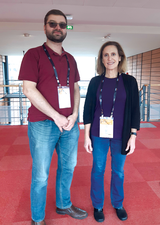Meet the FreeBSD Foundation
Interview – The FreeBSD Foundation

As the FreeBSD Foundation approaches its 20th anniversary, we talk to its top brass about the project's growing visibility in the open source ecosystem.
There's more to open source than Linux. FreeBSD, a free and open source Unix-based operating system, also plays an important role in the open source ecosystem. We talked to the FreeBSD Foundations's [1] executive director Deb Goodkin and director of project development Ed Maste at the recent Open Source Summit in Lyon.
Linux Magazine: Tell us about FreeBSD and the FreeBSD Foundation's long history.
Deb Goodkin: The foundation was founded in March 2000, so we're actually going to be celebrating our 20th anniversary March 2020. The original goal was to be sort of a legal entity that could hold any type of FreeBSD IP, and, at that time, it was the trademarks that we were given, so we've had ownership of trademarks and other IP since then.
[...]
Buy this article as PDF
(incl. VAT)
Buy Linux Magazine
Subscribe to our Linux Newsletters
Find Linux and Open Source Jobs
Subscribe to our ADMIN Newsletters
Support Our Work
Linux Magazine content is made possible with support from readers like you. Please consider contributing when you’ve found an article to be beneficial.

News
-
Two New Distros Adopt Enlightenment
MX Moksha and AV Linux 25 join ranks with Bodhi Linux and embrace the Enlightenment desktop.
-
Solus Linux 4.8 Removes Python 2
Solus Linux 4.8 has been released with the latest Linux kernel, updated desktops, and a key removal.
-
Zorin OS 18 Hits over a Million Downloads
If you doubt Linux isn't gaining popularity, you only have to look at Zorin OS's download numbers.
-
TUXEDO Computers Scraps Snapdragon X1E-Based Laptop
Due to issues with a Snapdragon CPU, TUXEDO Computers has cancelled its plans to release a laptop based on this elite hardware.
-
Debian Unleashes Debian Libre Live
Debian Libre Live keeps your machine free of proprietary software.
-
Valve Announces Pending Release of Steam Machine
Shout it to the heavens: Steam Machine, powered by Linux, is set to arrive in 2026.
-
Happy Birthday, ADMIN Magazine!
ADMIN is celebrating its 15th anniversary with issue #90.
-
Another Linux Malware Discovered
Russian hackers use Hyper-V to hide malware within Linux virtual machines.
-
TUXEDO Computers Announces a New InfinityBook
TUXEDO Computers is at it again with a new InfinityBook that will meet your professional and gaming needs.
-
SUSE Dives into the Agentic AI Pool
SUSE becomes the first open source company to adopt agentic AI with SUSE Enterprise Linux 16.

